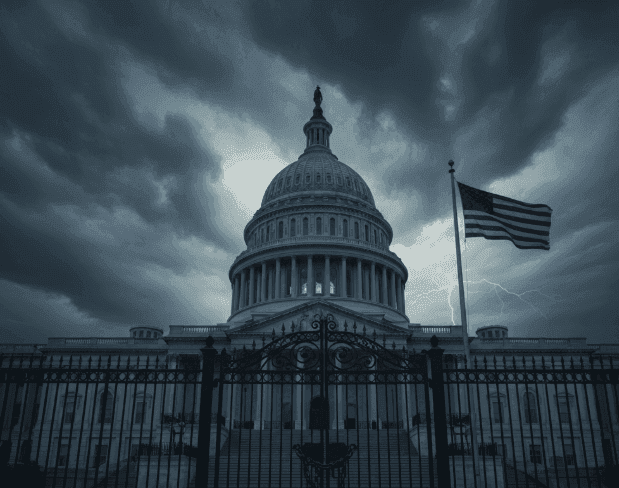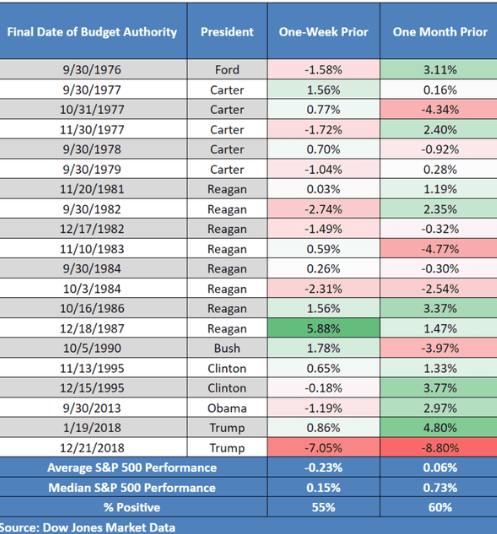
Shutdown or Not Shutdown?
US Government Shutdown: Real Threat or Opportunity for the Markets?
As the September 30, 2025 deadline quickly approaches, the specter of a US government shutdown once again haunts the markets. Budget disagreements between Democrats and Republicans suggest a legislative deadlock, likely to result in the temporary halt of non-essential federal government functions.
In a context where the global economy is already under strain—cyclical slowdown, high interest rates, and geopolitical uncertainties—the impact of a shutdown needs to be closely monitored. Yet, history shows that these episodes, though noisy, haven't always left a lasting mark on financial markets.
So, should we fear the worst? Or, on the contrary, prepare to seize investment opportunities?
What is a government shutdown?
A government shutdown occurs when the US Congress fails to pass a budget or a temporary funding bill (Continuing Resolution - CR) to finance federal agencies. This causes the halt or suspension of many public services.
Affected functions:
Closure of museums, national parks, administrative agencies (IRS, FAA, etc.)
Furlough of hundreds of thousands of federal employees
Suspension or delays of certain social benefits
Reduced workforce at the SEC, limiting market oversight
Blockage of major economic data releases
Shutdowns: A More Frequent Scenario
Since 1976, the United States has experienced 22 shutdowns. The longest was during the Trump administration, lasting 35 days between December 2018 and January 2019.
Historical evolution of shutdowns:

Analysis of the Current Political Context
The current situation blends three explosive elements:
- Republican majority in the House but divided between moderates and Trump loyalists
- Democrats demanding renewal of Obamacare subsidies
- White House threatening mass layoffs without approved funding
The Trump factor:
Donald Trump remains a blocking factor. By canceling a crucial meeting with the Democrats, he increased the risk of a budget stalemate.
Potential Economic Impacts of the Shutdown
Immediate Impact:
Frozen economic data:
Non-Farm Payrolls (employment)
Inflation (CPI)
Quarterly GDP
**Export paralysis**: no issuing of licenses
SBA loans and small business aid frozen
Delays in social payments, suspended medical tests
Market Consequences:
Increased volatility (VIX can rise from 14 to 25+)
Decrease in cyclical stocks
Reduced guidance from companies exposed to government contracts
What Does Historical Data Say?
According to MarketWatch:
S&P 500 -0.23% on average one week before the end of a shutdown
0.06% over a month, but 60% of shutdowns end with a positive performance
12-month return after a shutdown: positive in 19 out of 22 cases
Notable Example: 2013 Shutdown (Obama)
Duration: 16 days
Impact: S&P 500 +3.1% during the period
Markets Today Facing Shutdown Risks
Stock Indices:
- S&P 500: near historic highs
- Nasdaq: sensitive to macro data
- Dow Jones: more defensive, could weather the storm
Risk Indicators:
- VIX: around 14, dangerously compressed
- Fear & Greed Index (CNN): neutral, sensitive to the slightest shock
What Strategies for Investors?
1. Take a Contrarian Approach: Buy the Panic
History shows that markets often rebound after shutdowns.
Example:
Temporary loss of 5% on the S&P 500 → Bounce of 8-10% over 6 months
€100,000 investment → Potential gain of €8,000
2. Focus on Defensive Stocks
- Healthcare: Pfizer, UnitedHealth
- Food: Coca-Cola, Nestlé
- Utilities: NextEra, Enel
3. Gold and Long-Term Bonds as Safe Havens
- Gold: the ultimate safe haven asset
- Long-term bonds: falling yields = rising value
And What About the Fed?
Issues Caused by the Shutdown:
- Lack of data for the next FOMC
- Interest rate decisions more uncertain
- Possible precautionary pause in rate hikes
Economists' Views:
"The probability of a shutdown is >70%, but the short-term impact should remain moderate." — Goldman Sachs
"The shutdown could delay a Fed tightening." — Morgan Stanley
Shutdown: A Test of US Political Credibility
Potential Impact on US Debt:
- Risk of losing credibility
- Rating agencies could downgrade the AAA rating
- Increase in CDS (Credit Default Swaps)
Conclusion: Threat or Opportunity?
A government shutdown above all remains a political event. Its market impact is generally temporary but can trigger enough short-term noise to generate volatility.
The rational investor will see it as a buying opportunity, especially when fundamentals remain solid and historical performance is favorable.
**Go Further: Recommended Reading**
- This Time Is Different – Reinhart & Rogoff
- The Deficit Myth – Stephanie Kelton
- Irrational Exuberance – Robert Shiller
- US Shutdown History – CRS
- Latest Economic Reports – Beige Book
**FAQ – Government Shutdown and Financial Markets**
1. Will the government shutdown cause the stock market to crash?
Not necessarily. Historical data shows a moderate impact, except in the case of a parallel crisis.
2. Can you still receive social benefits during a shutdown?
Yes, but with possible delays in some payments.
3. Which economic data are affected?
Employment (NFP), inflation (CPI), GDP, consumer confidence. They may be suspended or delayed.
4. What is the average length of a shutdown?
Around 6 to 8 days. The longest lasted 35 days (Trump, 2018-2019).
5. Is this a good time to buy stocks?
Yes, historically shutdown-related selloffs have often been followed by strong rebounds.